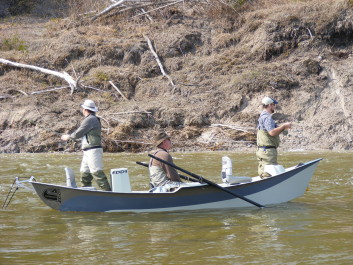Spring Steelhead (Part 3)
As mentioned in the previous articles, there are some differences between spring steelhead and fall steelhead that need to be addressed by anglers and recognizing and understanding these differences is sure to increase your success. First of all, the notion that returning steelhead discontinue feeding needs to be looked at. This is one of those topics that is up for debate and can become a long and drawn out conversation but the science strongly suggests that steelhead, like most anadromous fish, on their upstream migration don’t eat enough to put the angler in a match the hatch situation. (Great Lakes steelhead are not truly “anadromous” and would be considered “patamodromous, however their behavior is close enough to their west coast brethren that we can consider them similar enough).
The fact is though, that within days of entering the rivers estuary and their return to the rivers environs, feeding slows to a point that matching the hatch is no longer a paramount factor. So why do they take flies?
The three most commonly excepted theories are:
- Imprinting: Feeding behavior from the fish’s early life in the river to its sea roaming adulthood leaves an impression that stays with it. Parr and smolts feed and act just like trout during their time in the river after hatching. Aquatic invertebrates (caddis, mayflies, stoneflies, etc.) make up the majority of their diet with small vertebrates (minnows fry etc.) augmenting it. They feed voraciously during these stages prior to leaving the river for the ocean and the theory of “imprinting” relies less on their ability to recall or remember this behavior but more of an instinctive reaction triggered by their return to the rivers environment.
- Aggression: This theory is based on the idea that virtually no feeding occurs during spawning and that the single priority of both sexes is to procreate. This is not difficult to accept given what salmon and steelhead endure to reach suitable breeding habitat. In other words, the fish take on a “let nothing get in our way” attitude. The presence of a properly presented artificial fly in the proximity of a holding salmon or steelhead could trigger an aggressive response leaving the fish no option but to eat it or at least bite it. (Most fish have no other defensive weapon other than their mouths and their speed.)
- Curiosity: (taken from Brian Daverns article ‘Choosing flies for Steelhead’ Fly Fisherman magazine, April 1980) “All higher forms of life exhibit curiosity at times; it’s reasonable to assume that this fact can assist us in catching steelhead. Consider yourself watching what you know to be a white marble rolling slowly towards you. Unless you have a specific interest in marbles, you probably wouldn’t pick it up, being satisfied that it is a marble. On the other hand, if it passed you so quickly that you had no chance to see it well, you may chase it and pick it up. Who knows, it might be a pearl.”
We believe that it makes more sense to study the three ideas together, rather than attempting to disprove one, in favor of the other.
Fringe Opportunities
We have discussed the difference between kelted or drop back fish and fresh fish and their feeding habits (or lack of) but these differences can further impact what to look for in terms of conditions. Shedding steelhead will typically hang around the river and recharge for as long as the conditions allow them to. The two major factors that drive them back to the lakes would be water temperature and flows. High temps and high flows are the most impactful and will generally cause a mass exodus.
However, if the temperatures remain below 60 degrees and the rivers have not swelled to a point that makes for a quick and easy downstream run, the shedding steelhead will often take advantage of the conditions and hang around. The longer they are in the river, the more “trouty” they become and it is not beyond the realm of possibility to find fish feeding on emerging insects on or near the surface. We have, on occasion witnessed perfectly healed up kelts as late as early June. On one occasion on June 8th, we found what we believed to be large rainbow feeding on Red Foxes however, after hooking and fighting the fish, which we never managed to land, we estimated it to be between 7 and 12 pounds. It was unmistakably a late hold over steelhead but was acting just as the resident trout. This isn’t going to happen every day but if the spring is unseasonably cool, there is a good chance that you can find decent steelhead fishing into late May or even June.
Helpful Tips from GROF:
Take notes! Among the most important aspects of fishing, no matter your skill level is to understand your quarry’s behavior and reacting to changes. The best way to gain this information is to fish a lot, explore and put yourself in varying conditions and situations and then write it all down.
Things to take note of in your journal: Success, Barometric pressure, Moon cycles, Wind direction, Water conditions such as level, temperature and colour and air temperature.
GRO’s Steelhead Primer for spring is April 12th. For details, visit https://ontarioflyfishing.ca/courses/advanced-steelhead-tactics/

